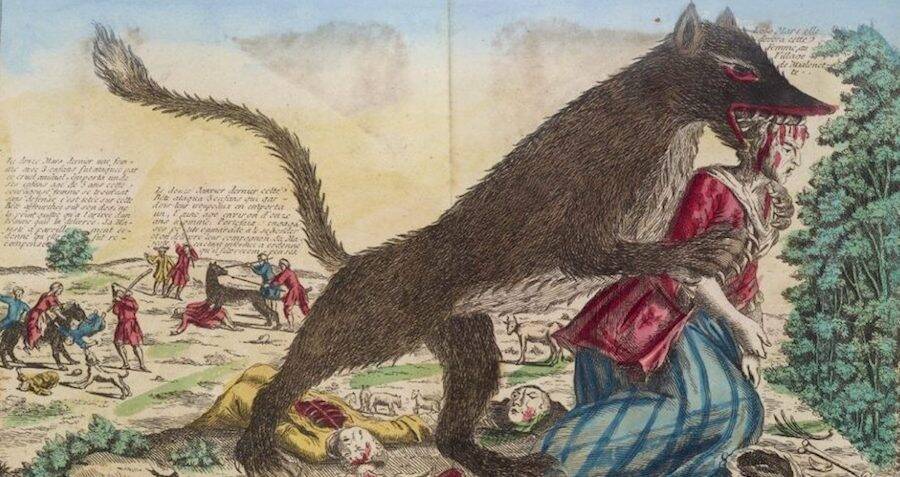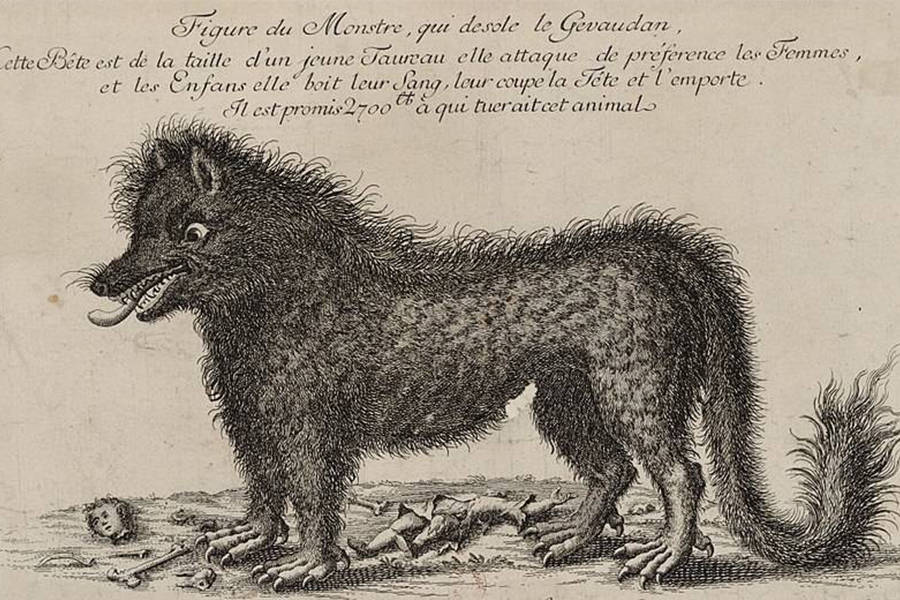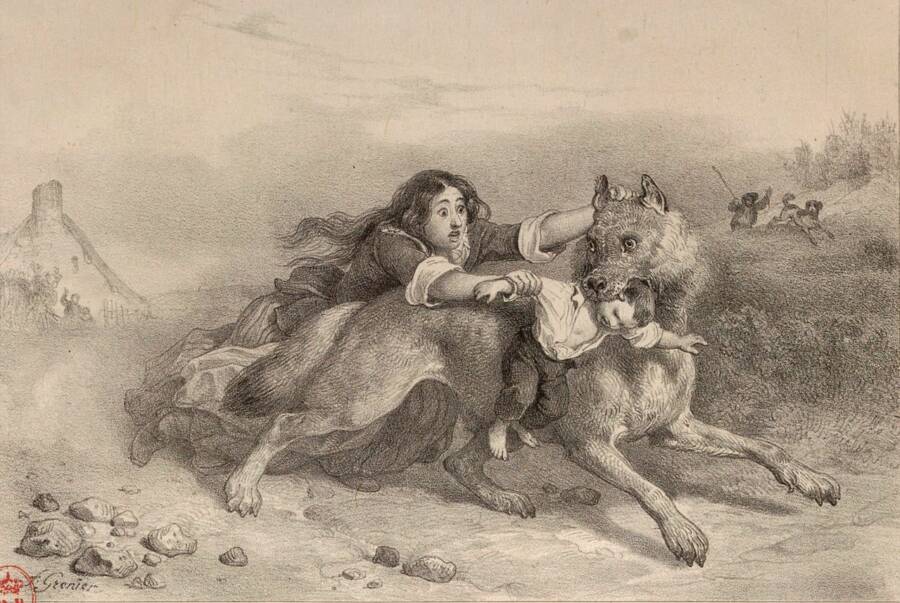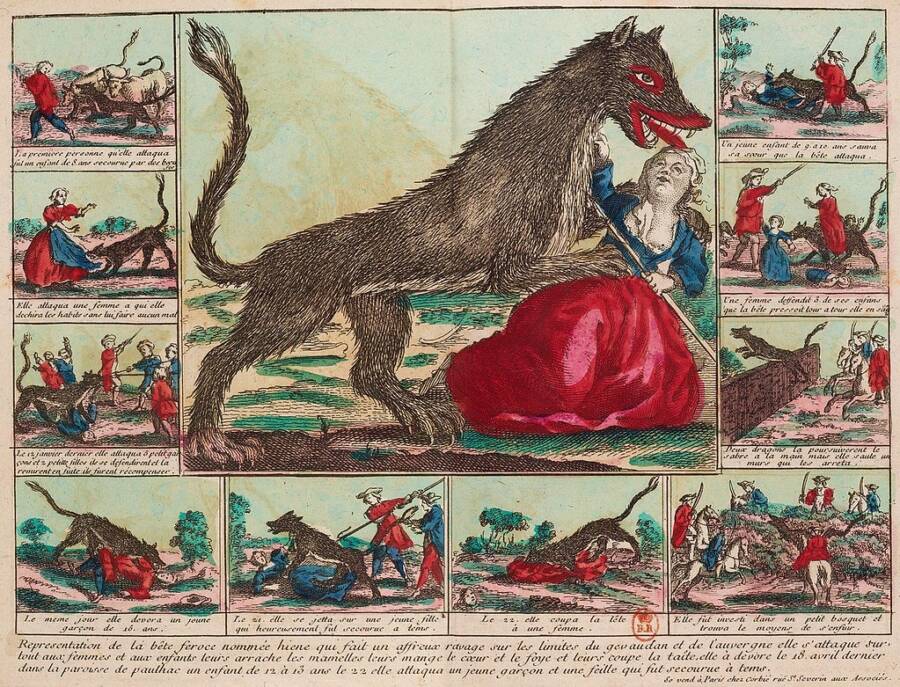
In the 1760s, a wolf-like monster known as the Beast of Gévaudan reportedly killed hundreds of people in gruesome fashion — and to this day, no one knows exactly what it was.

Wikimedia CommonsA 1764 rendering of the Beast of Gévaudan called “Picture of the Monster that is desolating Gévaudan.”
Between 1764 and 1767, something evil stalked the quiet hills of Gévaudan, France. The so-called Bête du Gévaudan, or Beast of Gévaudan, attacked hundreds of people, often tearing out their throats. No one knew what it was — or how to stop it.
For three years, the beast terrified villagers of this southern French region. And for three years, hunters came from far and wide to try and track it down. Even King Louis XV got involved.
But although something was killed by 1767 that put an end to the attacks, the mystery of the Bête du Gévaudan endures. Was it a mythical beast? A lion on the loose? Or simply a product of mass hysteria?
Listen above to the History Uncovered podcast, episode 32: The Beast Of Gévaudan, also available on Apple and Spotify.
The First Attacks By The Beast Of Gévaudan
Gévaudan was a quiet region, secluded safely in the mountains of Margeride in the south of France and largely cut off from the outside world. Life there was peaceful — until 1764.

Public DomainA depiction of the beast published in November 1764. It reads, “A picture of the fierce and extraordinary beast that eats girls.”
That year, a young woman watching a herd of cattle claimed that something terrifying had tried to attack her. She described the beast as “like a wolf, yet not a wolf.”
Two months later, at the end of June, something attacked and killed a 14-year-old girl named Jeanne Boulet while she was watching over her family’s livestock.
The villagers might have uneasily dismissed these incidents as par for the course — sheepherding could be dangerous work and attract predators. But on Aug. 8, another girl was killed. With her last breath, she described the animal as a “horrible beast.”
From there, the attacks kept coming. At the end of August, a young boy watching sheep disappeared, only to be found partially eaten. And four kills in September convinced residents of Gévaudan that an evil creature lurked in their midst.
They knew they had to do something.
Hunting The Mysterious Monster
Facing a terrifying and dangerous beast, the people of Gévaudan prepared a massive response. Jean-Baptiste Duhamel, the captain of the local infantry, and Étienne Lafont, a regional government delegate, were joined by 30,000 volunteers to hunt it down.

Public DomainAn illustration of Jeanne Jouve, whose attempt to save her child from the Beast of Gévaudan made her a national hero, 1839.
They scoured the countryside, laid traps with poisoned bait, and even had some volunteers dress like women in hopes of attracting the Bête du Gévaudan. The men were highly motivated. In addition to wanting to stop the beast, they also hungered after the reward money, which was equal to a year’s salary.
But although the group of hunters stumbled upon the beast, they failed to shoot it. They reported that the beast was too cunning and too powerful to be subdued.
“Hunters who are in pursuit have neither been able to stop it, because it is more agile than they,” a local French paper wrote at the end of 1764.
“Nor lure it into their traps, because it surpasses them in cunning, nor engage in combat when it presents itself to them, because its terrifying appearance weakens their courage, disturbs their vision, sets their hands shaking, and neutralizes their skill.”
Duhamel described the beast as having a “chest as wide as a horse,” “a body as long as a leopard’s,” and “red” fur with “a black stripe.” Another witness claimed that it could walk on its hind legs. Perhaps hoping to excuse the hunters’ failure, the witness also said that the beast’s skin could withstand and even repel bullets.
Even hunters who came from afar had no luck. A father-son team from Normandy who claimed to have killed more than 1,000 wolves came to Gévaudan to help. But even they couldn’t manage to kill the beast.
The People Of Gévaudan Fight Back
Locals often had better luck fending off attacks. A group of children in January 1675, led by 10-year-old Jacques Portefaix, were said to have driven off the beast with sticks. And a young woman named Marie-Jeanne Valet impaled the Beast of Gévaudan with a bayonet when it attacked her that summer.

Wikimedia CommonsAn 18th-century print of François Antoine shooting a wolf.
The problem got so bad that it began to attract the attention of the French king, Louis XV. Convinced that the Beast of Gévaudan was too much for the locals to handle, he sent his personal bodyguard, François Antoine.
At first, Antoine seemed to be the right call. He and his men shot and killed a giant wolf, stuffed it, and collected their reward. But a few months later, the attacks started up again.
This time, the beast seemed fiercer and more fearless. It attacked and killed scores of people, stirring up panic. The Beast of Gévaudan’s reign of terror didn’t end until June 19, 1767, when a local farmer — whom Antoine had earlier thrown in prison for leading him into a bog — shot and killed another huge wolf.
When residents cut the wolf open, they found human remains inside. Thus, the Beast of Gévaudan seemed to have been killed at last. The attacks stopped. But the mystery surrounding this odd story has endured to this day.
What Was The Beast Of Gévaudan?
To this day, no one is entirely sure what terrorized the people of Gévaudan in the 1760s. But several theories have emerged.

Public DomainAn engraving showing the many attacks of the Beast of Gévaudan, with Marie-Jeanne Valet’s piercing attack in the center, 1765.
The most prominent theory is that the beast was exactly what the first witness described — a Eurasian wolf. Or, more likely, the Beast of Gévaudan was a particularly aggressive pack of wolves. The animals are native to the region, and there are thousands of wolf attacks in France on record between the 17th and 19th centuries.
But the witness did not describe a wolf, exactly.
Other theories have suggested that the beast was an escaped exotic animal, like a hyena or a lion. Most people in France would have never seen animals like this, so they would appear like mythical beasts.
Duhamel even mused, “You will undoubtedly think, like I do, that this is a monster, the father of which is a lion. What its mother was remains to be seen.”
Then again, another theory suggests that the beast was actually the most terrifying creature on the planet — a human. Is it possible that a serial killer terrorized Gévaudan? Could a human have stalked through the region, searching for unaccompanied young children or women?
We’ll never know for sure. Maybe the Beast of Gévaudan simply slipped back into the mountains.